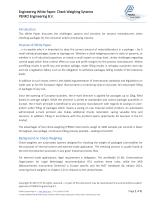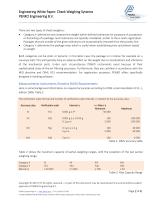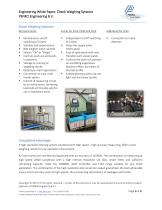
Excertos do catálogo

Engineering White Paper: Check Weighing Systems PENKO Engineering B.V. Introduction This White Paper discusses the challenges, options and solutions for process manufacturers when checking packages for the consumer and/or processing industry. Purpose of White Paper … is to explain why it is important to dose the correct amount of material/product in a package – be it small individual packages, boxes or big bags etc. Whether a check weighing system is static or dynamic, or whether it is of industrial proportion or simply a small system on shop level, similar challenges regarding control apply which have a direct effect on cost and profit margins for the process manufacturer. Where overfilling results in profit loss and product spillage, under filling results in unhappy customers and may even be a legislative fallacy such as the obligation to withdraw packages falling outside of the tolerance levels. In addition to such losses, there is the added argumentation of international standards and legislations on trade such as for the European region that warrants a scrutinizing view on accurate, fair and proper filling of packages of any size. Since the opening of European boarders, the e-mark directive is applied for packages up to 10kg, filled based on average weight. While the directive is aimed to standardize and control package quantities in Europe, the e-mark principle is beneficial to any process manufacturer with regards to savings on overand/or under filling of packages which means a saving on raw material and/or product. An automated administered e-mark protocol also makes additional checks redundant, saving valuable time and resource. In addition, filling in accordance with this protocol opens opportunity for business in the EU market. The advantages of fast check-weighing (PENKO instruments weigh at 1600 samples per second) is faster throughput, less spillage, continuous filling process possible – leading to fast ROI Background on Check-Weighing Check-weighers are automated systems designed for checking the weight of packaged commodities for the purposes of internal control and external trade application. The checking process is usually found at the end of production processes in any given industrial process flow. For external trade applications, legal requirement is obligatory. The worldwide O.I.ML. (International Organization for Legal Metrology) recommendation R51 outlines these rules, while the MID (Measurements Instruments Directive) is Europe specific and the NIST Handbook 44, edition 2014, covering check weighers in chapter 2.24 is relevant to the United States. Copyright © 2015 ETC All rights reserved – no part of this document may be reproduced of any kind without explicit approval of PENKO Engineering B.V. PENKO Engineering B.V. | www.penko.com | T +31 (0)318 525 630 V:\Public\MARKETING @ PENKO\CASE STUDIES & White Papers\Application White Papers //White Paper CHK
Abrir o catálogo na página 1
Engineering White Paper: Check Weighing Systems There are two types of check weighers: • Category X: determine and compare the weight within defined tolerances for purposes of acceptance or discarding of a package. Such tolerances are typically mandated, similar to the e-mark registration. Packages that are outside of the given tolerances are automatically removed from the process line. • Category Y: determine the package mass which is useful when establishing price calculations based Both categories can be static or dynamic. In the latter case, the package is in motion for example on a...
Abrir o catálogo na página 2
Engineering White Paper: Check Weighing Systems For a number of consecutive weighings of a net load greater than or equal to the minimum capacity, (Min) and less than or equal to the maximum capacity, (Max) the maximum permissible mean (systematic error) shall be as specified in Table 3. Net load, m, expressed in verification scale intervals, e Maximum mean error for Table 3: Min/Max permissible capacity The maximum permissible standard deviation of the error (random error) shall be as specified in Table 4, multiplied by the class designation factor (x). Value of the mass of the net Maximum...
Abrir o catálogo na página 3
Engineering White Paper: Check Weighing Systems The maximum permissible error for any load greater than or equal to the Min and less than or equal to the Max in automatic operation shall be as specified in Table 5. Load, m, expressed in verification scale intervals, e Maximum permissible error for Initial In-service verification inspection Table 5: Max permissible error Below are two typical examples of a static or dynamic class Y check weighers. The first graphic depicts a pusher -; the second image shows discrimination of under- and overweight. belts separately controlable overflow...
Abrir o catálogo na página 4
Engineering White Paper: Check Weighing Systems PENKO Engineering B.V. PENKO instruments excel in these applications because of the sophisticated state-of-the-art filtering processes. Instruments are certified and approved in accordance with the MID and O.I.ML. Unique software, based on the e-marking protocol, allows for registration. The data transfer software enables data transfer directly to a printer or a centralised storage base on a personal PC. Where filling on average weight is not permitted, this feature still offers excellent data analysis opportunity to optimise filling results....
Abrir o catálogo na página 5
Engineering White Paper: Check Weighing Systems PENKO Engineering B.V. Check Weighing Solutions All Instruments Simultaneous on/off switching of 3 belts Variable belt speed option Belt weigher input controls Selects “OK” or “Reject” Controls push-out and pushin positions Storage or printing of weighing results Optional e-mark registration Connection to a bar code reader option Control of measuring circuit by an active sense, rendering load cells intrinsically safe for use in hazardous areas Independent on/off switching of 3 belts Stops the supply when interrupted Ease of operations with...
Abrir o catálogo na página 6
Engineering White Paper: Check Weighing Systems PENKO Engineering B.V. Product Solution The SGM800 range of digitizers/controllers is a compact device for use as standalone controllers in network configurations, fulfilling a specific check function. All models offer 3 inputs and 4 outputs. A selection can be made, depending on the model, portal Ethernet (TCP) with protocols Modbus, FINS, Ethernet-IP and ASCII, portal RS232/422 with protocol Modbus and ASCII as well as portal Profibus with protocol Profibus-DP. Protocols for printers, web browsers, and configuration software and between...
Abrir o catálogo na página 7Todos os catálogos e folhetos técnicos PENKO Engineering B.V.
-
Type BSP
2 Páginas
-
Type 9363
2 Páginas
-
Type 650
2 Páginas
-
Type 620
2 Páginas
-
615-616
2 Páginas
-
Type 619
2 Páginas
-
Type 615
2 Páginas
-
Type 614
2 Páginas
-
Type 610
2 Páginas
-
Type 750i
2 Páginas
-
Type 460
2 Páginas
-
Type 750a
2 Páginas
-
Type 5103
2 Páginas
-
Type 4158
2 Páginas
-
Type 740
2 Páginas
-
Type 420
2 Páginas
-
Type 122
2 Páginas
-
Type 120
2 Páginas
-
Type 700
2 Páginas
-
SIGMA4
5 Páginas
-
1020 Indicator
4 Páginas
-
Penko ENGINEERING B.V
5 Páginas
-
FLEX Multi Channel Extended
6 Páginas
-
Printer Label Desktop CLP-521
1 Páginas
-
Force Measuring Instruments
8 Páginas
-
PENKO CATALOGUE 2016
32 Páginas
-
REL SHBxR
2 Páginas
-
REL RLC
2 Páginas
-
REL HPS
2 Páginas
-
REL BSP
2 Páginas
-
REL ACB
2 Páginas
-
REL 9363
2 Páginas
-
REL 5103
2 Páginas
-
REL 178 SILOWEIGH
2 Páginas
-
FLL ZLB
2 Páginas
-
FLL ULB
2 Páginas
-
FLL UB6
2 Páginas
-
FLL UB1
2 Páginas
-
FLL SLB
2 Páginas
-
FLL SB9
2 Páginas
-
FLL SB8
2 Páginas
-
FLL SB6
2 Páginas
-
FLL SB5
2 Páginas
-
FLL SB4
2 Páginas
-
FLL SB2
2 Páginas
-
FLL SB14
2 Páginas
-
615-6
2 Páginas
-
Type 300
2 Páginas
-
Type PBW
2 Páginas
-
Type SB6
2 Páginas
-
Type SB14
2 Páginas
-
Type SB2
2 Páginas
-
Type 1030
2 Páginas
-
Type 1015
2 Páginas
-
Type 140
2 Páginas
-
Type 190a
2 Páginas
-
Type 160
2 Páginas
-
Type KVD
1 Páginas
-
Speed Wheel Kit
1 Páginas
-
RIA700 Remote Analog I/O
2 Páginas
-
RIO700 8-Channel Remote I/O
2 Páginas
-
Type Load Cell Simulator LCS-3
2 Páginas
-
PENKO FLEX2100 RANGE
5 Páginas
-
PENKO FLEX MULTI-CHANNEL RANGE
7 Páginas
-
PENKO 960
2 Páginas
-
PENKO1020 Brochure
4 Páginas
-
FLL RC3
2 Páginas
-
FLL RC1
2 Páginas
-
FLL PCB
2 Páginas
-
FLL PC60
2 Páginas
-
FLL PC6
2 Páginas
-
FLL PC46
2 Páginas
-
FLL PC42
2 Páginas
-
FLL PC30
2 Páginas
-
FLL PC2
2 Páginas
-
FLL PC1
2 Páginas
-
FLL PBW
2 Páginas
-
FLL PB
2 Páginas
-
FLL CPB
2 Páginas
-
FLL BK2
2 Páginas
-
ASL IBM3 IP68
2 Páginas
-
ASL IBM3 IP67
2 Páginas
-
ASL IBM2 IP68
2 Páginas
-
ASL IBM2 IP67
2 Páginas
-
ASL IBM1 IP67
2 Páginas
-
ASL IBM1 IP68
2 Páginas
-
UTL 190
2 Páginas
-
UTL 160
2 Páginas
-
1020 Series
4 Páginas
-
SGM700
4 Páginas
-
SGM800
5 Páginas
-
Brochure Checkweigher
3 Páginas
-
Corporate Penko Engineering Brochure
5 Páginas































































































